
The Last Train to Mildenhall[Source: Darren Kitson] The title is something of a misnomer and would be more correct, albeit confusing, if the word 'trains' was used instead of 'train'. This is because the rather strange service pattern of the Mildenhall branch towards and at the end of its life gave a number of routes and destinations to and from the branch which are listed below. Technically speaking, all of these had a last train.
There was also a Saturday- only Cambridge - Fordham (and return) service which connected with the Ely service. This and all other services listed ran until and including the final day of Mildenhall branch passenger services on Saturday 16 June 1962. Before we move fully onto details of the last train(s), some explanation of timetable details and how formats changed, using 1958 and the final 1962 timetables, might be in order to allay a degree of confusion which exists with old timetables owing to the passage of time. Some images which appear below may also appear in other pages covering the Mildenhall branch but this is a necessary duplication.
The service from Ely is also confusing. It returned from Mildenhall at 11.12am but did not run to Cambridge via Newmarket as the timetable implies. It ran only as far as Newmarket, where passengers for Cambridge needed to change, before returning direct to Ely with a local service calling at Fordham and Soham. In the up direction, the inclusion of Mildenhall was therefore in effect an 'add on' to the pre-existing Ely - Newmarket service. The summer 1958 timetable was current when railbuses were introduced to the Mildenhall branch, which is why no distinction between steam and diesel was shown as was later the case. Similarly there is no mention of the diesels being second class only. These factors add some weight to the suspicion that the introduction of railbuses to the branch was a last minute decision. Note the figure '9' beside Barnwell in the up timetable; this is a error for 19, Barnwell being ¾-mile from Fen Ditton Halt. The reference to 'special car' in the footnote refers to the steam-hauled conductor-guard trains which were still operating when this timetable was published. In subsequent timetables the mention of Quy was removed even though tickets from that station continued to be issued by the guard. Quy was manned until closure but only on a part time basis while its booking office had been a casualty of LNER economy measures.
During 1961, British Railways undertook a survey of passenger numbers on the Cambridge to Mildenhall via Burwell, Cambridge to Mildenhall via Newmarket, Newmarket to Ely and Mildenhall to Ely services. The surveys were undertaken over two separate six day periods approximately five months apart and the above tables have been compiled using the data collected by BR. The tables are a simplified, self explanatory version of those produced by BR. Passenger surveys were undertaken in the same way across the country, with Monday - Friday figures averaged and Saturday figures actual, including into the Beeching era. The BR Report, published in October 1961, made mention of only certain services between Newmarket and Ely. This rather complicates things in the context of the Mildenhall branch but was connected with retimings of other services to compensate for the then proposed loss of services between Mildenhall, Fordham, Ely and Newmarket. For the same reason there were other changes to Ipswich/Bury - Cambridge services to compensate for the loss of Mildenhall - Cambridge via Newmarket services including additional station calls. The figures given in these tables ignore passengers travelling between Cambridge and Newmarket by means of Cambridge - Bury/Ipswich services but therein lay the problem with these surveys conducted over routes shared by services other than those proposed for withdrawal. For example, a passenger might travel from, say, Fulbourne to Newmarket on a Bury or Ipswich service but make the return journey on an ex-Mildenhall service and the ticketing system in use at the time made this degree of scrutiny no simple task for the accountants. In theory the route taken by a passenger could be determined by identification of the ticket clipper used by guards but in practice it was by no means that simple. BR, especially during the Beeching period (it should be remembered the withdrawal of the Mildenhall branch passenger service was not a Beeching cut), came under much criticism for the way they conducted surveys but in fairness they used what was really the only practical means available and the results were accurate enough for the purpose. All figures given in the above tables were dire and it is clear the bulk of passenger journeys were between Mildenhall, Isleham and Newmarket as well as to Cambridge via Newmarket or vice versa. By default this makes it clear the situation on services via Burwell was even more dire and during the w/e 11/02/61 Swaffham Prior saw no passengers at all. The reasons are not hard to understand; the train service via Burwell was virtually non existent towards the end and the Burwell - Cambridge corridor was very well served by buses of, in particular, the Burwell & District Motor Service, which dumped passengers right in the centre of Cambridge as well as actually passing through the villages along the way - unlike the railway where stations such as Bottisham and Quy were quite a trudge from the villages and in all weathers. As readers will deduce, the dashes in the tables represent zero passengers and the halts at Fen Ditton and Exning Road saw no passengers at all during the two survey periods. Figures for Fen Ditton Halt (which, like Barnwell Junction, was within the City of Cambridge) are hardly surprising as it was just a short walk from the frequent Cambridge City bus service No.133 (as it was at the time) which terminated at nearby Keynes Road. Exning Road Halt was just beyond the eastern edge of Burwell but for all intents and purposes was in the middle of nowhere with just a few cottages nearby. It was 1½ miles from Exning village which itself lies on the outskirts of Newmarket. Worlington Golf Links Halt became well known as the most used of the three halts and this is clear from the tables but, even so, crowd control measures were hardly necessary and most passengers using the halt would have been for the adjacent golf links. Providing it was a fine day it was an easy walk or cycle ride from Worlington village into Mildenhall and it is said that this is what most people did. An irritating (very) aspect of modern life is ill-informed television presenters (and some websites) who claim the withdrawal of all railway passenger services was a result of The Reshaping of British Railways, better known as 'The Beeching Axe'. This was not the case with Mildenhall as the withdrawal of passenger services predated Dr Beeching's report. The branch was, however, mentioned in the report but under a proviso which read along the lines of 'May have already been withdrawn'. This was common in the report and applied to several lines across the country. The branch goods service, which finally ended in 1965, was a victim of Dr Beeching, insofar as Beeching's drive to rid the railways of pick-up goods trains and individual wagon load traffic was concerned. But Beeching or no Beeching, the branch goods would not have survived anyway due to the increasing amount of goods going by road. Even sugar beet and coal, those one-time life extenders of many branch lines, had dwindled to just a few wagon loads and sugar beet was, in any event, a seasonal product.
The final passenger timetable for the Mildenhall branch is seen above. This timetable was current from 11 September 1961 to 17 June 1962. The latter date was a Sunday and as no trains ran on the Mildenhall branch on Sundays (other than occasional excursions) the last trains ran on Saturday 16 June with the official closure date being on and from Monday 18 June 1962. As can be seen, the timetable format has changed from the 1958 example shown earlier and is somewhat clearer to understand - providing one reads the codes properly. Inserted in some of the Cambridge times is the letter C, for Connecting Service. The C and the 'Via Newmarket' meant passengers needed to change at Newmarket. This, it will be noted, also applied to what was to be the last train from Mildenhall, the 7.31pm. Unfortunately the 7.31pm from Mildenhall has come to be frequently mis-described as a 'Mildenhall to Cambridge via Newmarket' service. What this train actually did will be described later. Both 'positive' and 'negative' forms of the D indication are explained at the bottom of the timetable but 'Diesel Train. Second class only' did not necessarily imply a railbus as many DMUs were also second class only; it merely allowed for a railbus to be used if necessary as railbuses were used, on the Mildenhall branch, turn and turn about with DMUs during the final 18 months or so. The same train which departed Cambridge at 4.21pm operated all services on the branch for the rest of the day and sometimes it was a railbus but much of the time it was a DMU. A railbus did operate the 4.21pm and thereafter on the penultimate day, Friday 15 June, however. When it was a railbus and it eventually made it back to Cambridge, it ran light from Cambridge to Audley End or Bartlow to take up service on the Saffron Walden branch. When the 4.21pm (etc) was a DMU, the railbus due to relieve that at Saffron Walden simply ran light from Cambridge diesel depot with the driver returning to Cambridge with the relieved railbus. The 6.37am from Cambridge ran, it will be noted, non-stop to Fordham yet took one minute longer that the 4.21pm stopping service. The reason is not known. The 6.37am returned from Mildenhall at 7.34am and this was the service which ran through to Chappel & Wakes Colne and was, providing one was available, a railbus. This ceased when the Colne Valley Line closed on New Year's Day 1961 and thereafter the 6.37am and 7.34am return were usually operated by a DMU. Railbuses therefore never had a monopoly on the Mildenhall branch and their use was, it could be said, spasmodic. By September 1961, the Ely - Mildenhall service returned to Ely and not Newmarket. On Saturdays it connected with a Cambridge - Fordham and return service. The Ely service was invariably a Derby Lightweight DMU and the Cambridge - Fordham service was usually a DMU of one type or another. From this it can be seen that stations/halts Barnwell to Exning Road inclusive had no service to Fordham or Mildenhall on Monday to Friday until late afternoon. The Mildenhall - Newmarket services, which had been around since before the diesels appeared, were an attempt to generate more business for the Mildenhall end of the branch. It was a well-meant effort in theory but in practice it was a disaster. Newmarket had a number of excuses for a night out including cinemas of which in the 1960s the Kingsway and Doric were still in business. Both were on the High Street, a few minutes’ walk from the railway station. This was all well and good, but people travelling from Mildenhall, Worlington or Isleham for an evening in Newmarket could not get home again. The best on offer was a daytime trip to Newmarket with the outward journey involving a change at Fordham but the service, on the Mildenhall branch and to a lesser degree the Ely - Newmarket line, was just too sparse to be attractive. Economies had been made over the years, and when diesel trains were introduced there was an upturn in passenger numbers, but no attempt was made to provide anything like an attractive service or even speed up the trains which did run. The then-new diesels continued to plod along on what were essentially steam timings and, thanks to their better acceleration meaning early running, with excessive dwell times at lonely stations, well away from the places they were built to serve, to await time. Despite some protests (probably mainly from people who never used the railway anyway) and a belief that the introduction of diesel trains meant the line had a secure future, it was therefore no great surprise when Wickham DMU E50416/E56171 rasped out of Mildenhall station with the last passenger train at 7.31pm on Saturday 16 June 1962. In reality the nails had been hammered into the Mildenhall branch's coffin before it had even been completed as its intended purpose, a flood-avoiding alternative route to Thetford, was by then redundant.
The final train from Cambridge calls at Bottisham & Lode on Saturday 16 June 1962; the 4.21pm ex-Cambridge, due Bottisham at 4.35pm. During the currency of the final Mildenhall branch passenger timetable, this service was the only through journey between Cambridge and Mildenhall to call at Bottisham. On 16 June 1962 it was therefore the very last passenger service on the Barnwell - Fordham section, the train eventually returning to Cambridge by means of Mildenhall - Newmarket and Newmarket - Cambridge services. On the platform are presumably local people Janet, Heather and Ross Hatley, the latter being largely obscured by the ladies. The open doors of the Wickham DMU will be mainly CURC members hopping off to take photographs rather than a surge of disembarking ordinary passengers. At the end of the platform Bottisham signal box can be seen and, just beyond, the lower quadrant down starter signal which is 'off' for Wickham to rasp away towards Swaffham Prior. Original photographer unknown. Image from Lode with Longmeadow, Cambridgeshire Community Archive Network and reproduced under that website's not-for-profit Terms and Conditions. Wickham DMU E50416/E56171 arrives at Burwell with the 4.21pm Cambridge - Mildenhall service. This was the final passenger service on the Barnwell Junction - Fordham section. The signalman is standing on the platform ready to exchange single line tokens. The driver is looking straight ahead and with both hands on the controls so the token exchange will be between signalman and guard. This practice was not uncommon and the guard would need to inform the driver that the exchange had been undertaken successfully, otherwise the driver would not have authority to continue. Assuming the train to be on time, it is 4.43pm at Burwell and just a handful of people have turned out to witness Burwell's final passenger train. It is, however, known that a few more people had positioned themselves on the adjacent road bridge. Wickham at Worlington Golf Links Halt, bound for Mildenhall. The train is the 4.21pm from Cambridge - the final down service via Burwell as photographed there and at Fordham. The time is 5.3pm and Wickham was still to rasp through Worlington three more times. The photographer informs us all the people visible had alighted from the train and that there was a couple more people behind the photographer who had also alighted. Note the charming period clothing and the diamond shaped weight limit sign up on the road. The question has been asked many times why the GER did not build simple but proper platforms at the halts - after all there was always a supply of redundant sleepers available - but ground-level halts were common on the GER system. The obvious answer was cheapness, but then any savings made in this department, in steam days, were lost by the need to convert rolling stock and dedicate it to the branch. Arrival at Mildenhall for the 4.21pm from Cambridge was 5.9pm. The train then departed Mildenhall at 5.15pm for Newmarket, where it terminated in the bay platform at 5.41pm. Passengers off this train wishing to continue to stations to Cambridge changed onto an all-stations Bury St Edmunds to Cambridge service which departed Newmarket at 5.59pm and reached Cambridge at 6.24pm. The Mildenhall train then departed Newmarket at 6.26pm, having connected at Newmarket with the 5.56pm ex-Cambridge local service to Ipswich which called at Newmarket at 6.22pm. Passengers thus had four minutes to get off the train from Cambridge and scuttle via the subway to the bay platform and board the Mildenhall train. It is easy to forget that Newmarket station once had a subway. The 5.56pm Cambridge - Ipswich was a Saturdays Only service. On Monday - Friday passengers used the Saturdays Excepted 6.13pm from Cambridge which called at Newmarket at 6.38pm. The Mildenhall train then departed Newmarket at 6.45pm. The 6.13pm from Cambridge was in fact the down Bury St Edmunds portion of ‘The Fenman’; 4.56pm ex-Liverpool Street which, beyond Cambridge, omitted Fulbourne but called at Six Mile Bottom, Dullingham and Newmarket then ran non-stop to Bury St Edmunds. It was for reason of the differing Saturday connections from Liverpool Street and/or Cambridge that the final Down service to Mildenhall ran at a different time on Saturdays. Earlier an explanation was mentioned of what actually happened regarding the 7.31pm from Mildenhall which, of course, was to be the very last passenger train to serve the Mildenhall - Fordham section as the 4.21pm from Cambridge had been the final train to traverse the entire branch. It has become the norm to state the 7.31 was a Mildenhall - Cambridge via Newmarket service but in practice the operation was a little more complex. The train arrived at Newmarket at 7.57pm and terminated in Newmarket's bay platform. Passengers for Cambridge then changed onto the 7.2pm SO or 7.8pm SX Ipswich - Cambridge service which called at Newmarket 8.15pm SO or 8.20pm SX. This train stopped at all stations apart from Claydon, Dullingham, Six Mile Bottom and Fulbourne but on Monday - Friday it omitted Kennett and on Saturdays it omitted Saxham & Risby but did call at Kennett. These variations account for the different arrival times at Cambridge shown on the final Mildenhall branch timetable. Following departure of the Ipswich - Cambridge train from Newmarket, the train ex-Mildenhall then shunted out of the bay platform into Newmarket's up platform and formed the 8.28pm Newmarket - Cambridge local calling at Dullingham, Six Mile Bottom and Fulbourne before arriving Cambridge at 8.51pm. Passengers from the Ipswich - Cambridge service wishing to alight at stations beyond Newmarket would therefore change onto this train. It is because the ex-Mildenhall train operated a separate service from Newmarket that the 8.51pm arrival at Cambridge was not shown in the Mildenhall branch timetable. Passengers from stations Mildenhall - Fordham wishing to alight at stations between Newmarket and Cambridge could, however, remain on the train while it waited in Newmarket's bay platform and this bonus was advertised in the Ipswich - Cambridge timetable. The main purpose of the 8.28pm Newmarket - Cambridge service was to return the train, which had set out from Cambridge at 4.21pm, to Cambridge depot. The 7.2pm or 7.8pm Ipswich - Cambridge could still be steam-hauled and Saturday 16 June 1962 was to be the final day a steam locomotive could in theory appear. In practice, however, a diesel locomotive was more likely to appear by this date. By modern standards these trains were tediously slow and a stopping Ipswich - Cambridge service took on average 1hr 40mins. But then when we consider modern trains only cover the journey in 1hr 15mins to 1hr 20mins with far fewer stops, perhaps the times of over half a century ago were not so bad after all. Mildenhall branch trains were also slow, with the average speed being only in the region of 22mph. The Mildenhall - Newmarket service was introduced in steam days as an attempt to generate more business but passengers to or from Cambridge via this route were discouraged by the change at Newmarket which in the up direction (to Cambridge) added considerably to the journey time.
This was the standard style of entry in the next edition of BR timetables following withdrawal of a passenger service. It was a legal requirement to inform intending passengers of alternative omnibus services. At the time of writing Eastern Counties are now First Norfolk and Suffolk, or something like that, while Burwell & District closed down in 1979. The latter company is the best-known former competitor to the Mildenhall branch, especially between Burwell and Cambridge. Morley's Grey was a well-known bus and coach operator in the region who ran a number of contract and stage carriage services as well as tours and excursions. The company ceased trading in the 1980s. West Row is a small village just west of Mildenhall and not far from Worlington. Fordham and District Motors, to use its best known name, was a now-almost-forgotten operator with its depot on Mill Lane, Fordham. It was started by the Palmer family in the 1920s and like Burwell and District was a major competitor to the local railways, particularly on market days with services to Ely, Mildenhall, Newmarket, Cambridge and Bury St Edmunds. They also operated contracts from the Fordham area to Cambridge for the Pye factories, as did other companies. Fordham and District ceased trading rather suddenly in 1966. Its services and contracts were taken over by 'Paddy' Harris's Progressive Coaches’ of Cambridge. For a time Progressive also used, but did not own, the Mill Lane depot. Progressive themselves ceased to exist in 1974. Thus the omnibus operators who provided replacement services for the Mildenhall branch have now themselves vanished from the scene, their services either having disappeared altogether or integrated into those of First Group or Stagecoach. Photos by David Pearson, 1961 & 1962 BR Eastern Region timetables from Alan Young.
|
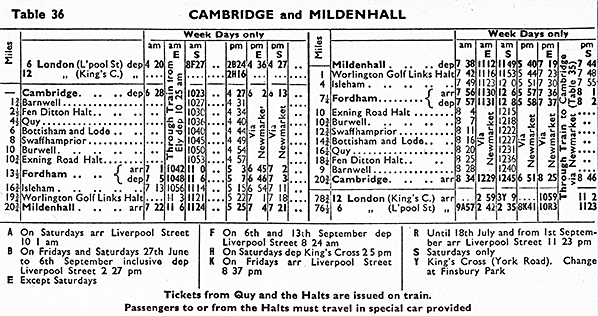
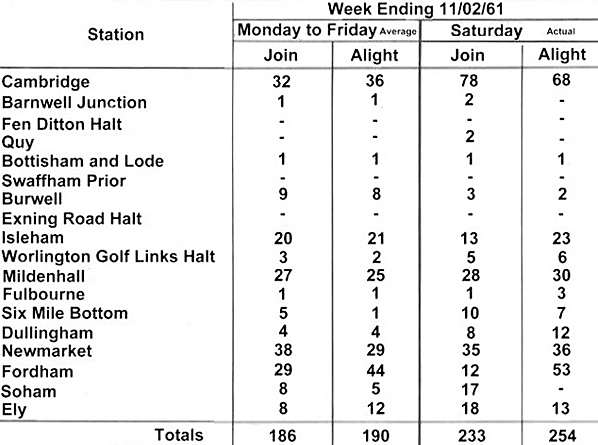
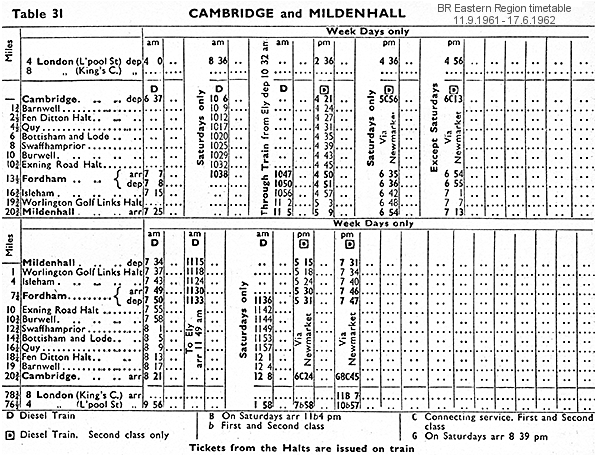
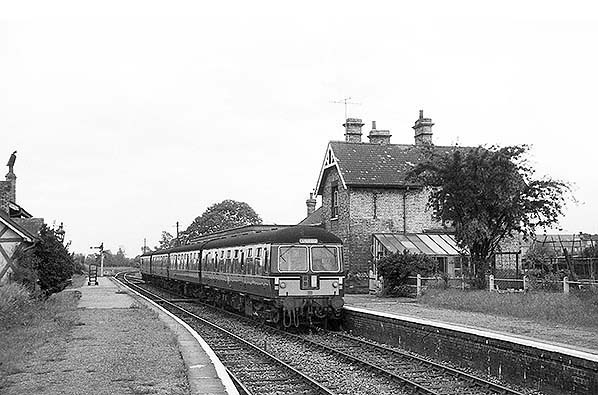
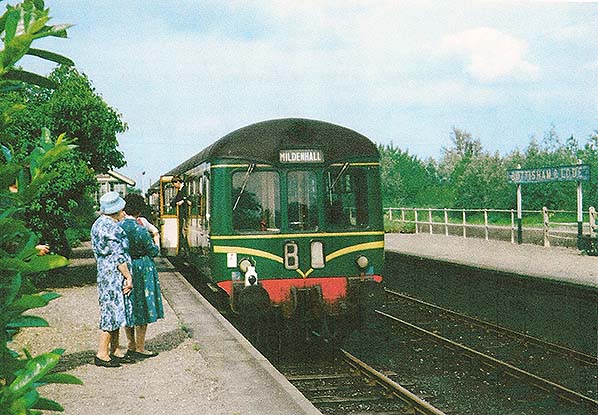
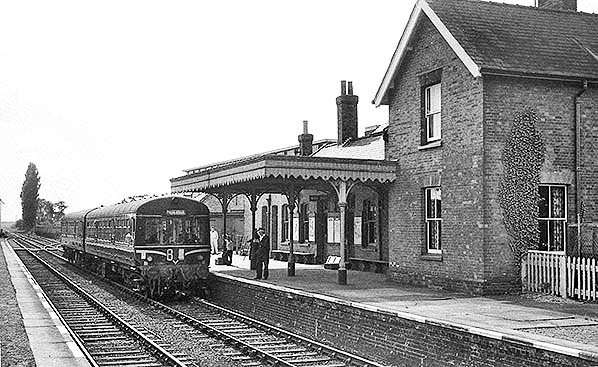
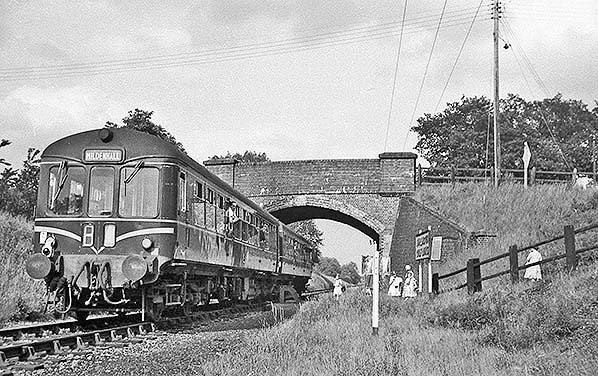
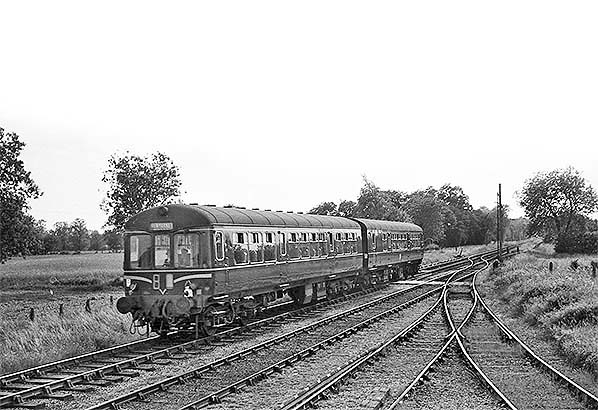
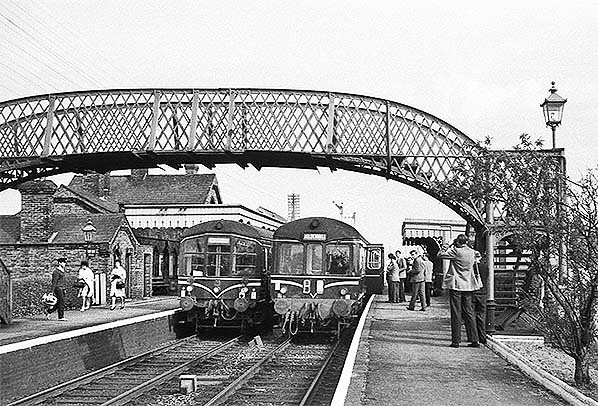
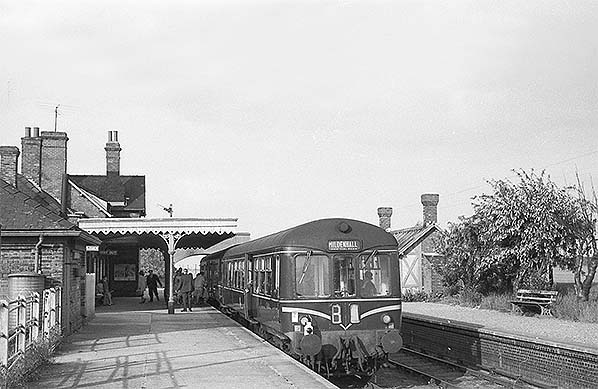
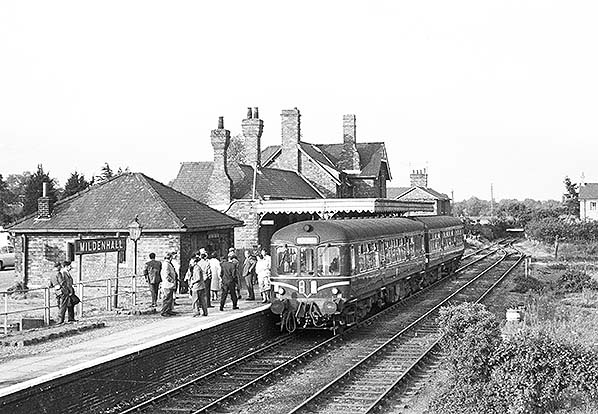
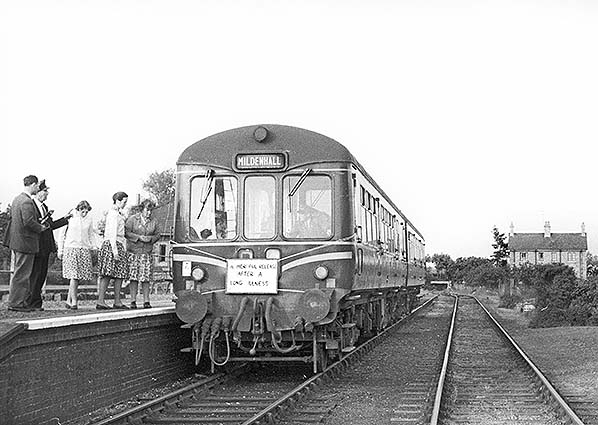
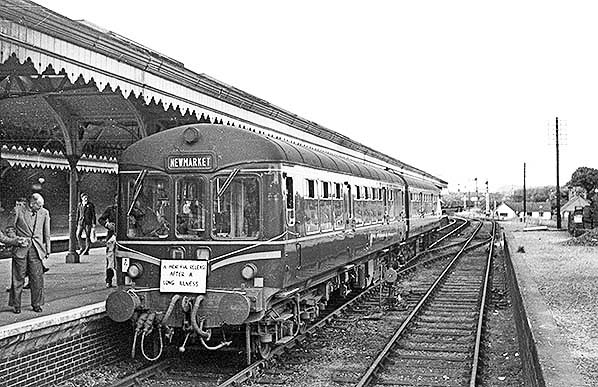


 Home Page
Home Page